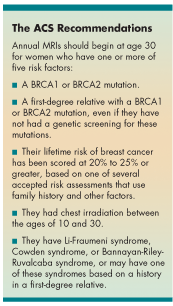MRI Finds Contralateral Breast Tumors That Were Missed by Mammography
Magnetic resonance imaging (MRI) of the contralateral breast in 969 women newly diagnosed with cancer in one breast detected 30 (3.1%) contralateral breast cancers that were missed by mammography and clinical breast exam at the time of diagnosis.
SEATTLEMagnetic resonance imaging (MRI) of the contralateral breast in 969 women newly diagnosed with cancer in one breast detected 30 (3.1%) contralateral breast cancers that were missed by mammography and clinical breast exam at the time of diagnosis. "We can now identify the vast majority of contralateral cancers at the time of a woman's initial breast cancer diagnosis," said principal investigator Constance Lehman, MD, PhD, professor of radiology and director of breast imaging at the University of Washington and the Seattle Cancer Care Alliance. "Although no imaging tool is perfect, if the MRI is negative, the chance of cancer in that breast is extremely low. A potential outcome that we would be delighted to see is fewer unnecessary bilateral mastectomies."
Dr. Lehman and her colleagues in the National Cancer Institute-funded American College of Radiology Imaging Network (ACRIN) conducted the study in nearly 1,000 women following their first diagnosis with breast cancer. They reported the results in the March 29 issue of the New England Journal of Medicine (356:1295-1303, 2007).
Simultaneously, the American Cancer Society (ACS) published new MRI guidelines in the March/April CA: A Cancer Journal for Clinicians (57:75-89, 2007) recommending that women at extremely high risk of breast cancer receive an MRI exam along with their annual mammogram (see Table). "The two tests together give doctors a better chance of finding breast cancer early in these women, when it is easier to treat and the chance of survival is greatest," the ACS said in announcing the guideline.

Of the 178,480 women that the ACS projects will receive a first-time diagnosis of breast cancer in 2007, approximately 10% will develop a tumor in the other breast, a statistic that emphasizes the importance of the ACRIN study's finding that MRI can pick up tumors missed by other common examinations.
"This means that instead of those women having another cancer diagnosis years after their initial treatment, we can diagnose and treat those opposite breast cancers at the time of the initial diagnosis," Dr. Lehman said.
Dr. Lehman and her colleagues enrolled 1,007 women between April 1, 2003, and June 10, 2004, who had recently received a diagnosis of unilateral breast cancer at 25 sites ranging from academic centers to private practices. The study protocol limited eligibility to women age 18 and older with a breast cancer diagnosis made within 60 days of enrollment and a normal clinical and mammography finding in the contralateral breast no later than 90 days before accrual. It excluded women who had had an MRI within the previous 12 months. Of the 1,007 women enrolled, 20 were later found ineligible, and 4 eligible women withdrew from the study; an additional 14 women did not undergo the required MRI examination, leaving 969 women as participants (average age, 53).
As the result of positive MRI examinations, the researchers recommended that 135 women (13.9%) undergo biopsy, and 121 of them did so.
A total of 33 contralateral breast cancers were diagnosed among the study participants within 1 year of study entry30 as the result of a positive MRI exam and biopsy, 1 from a mastectomy specimen from a woman with MRI findings that suggested BI-RADS 3 (probably benign), and 2 from prophylactic mastectomy specimens from women with MRI findings interpreted as BI-RADS 1 (negative). These latter 3 tumors representing false-negative MRI examinations were pure ductal carcinoma in situ (DCIS).
The 30 women with MRI-detected, biopsy-proven contralateral breast cancers equaled 3.1% of the participants screened in the study and 24.8% of the women biopsied. "All of the cancers detected by MRI were node negative, and 40% were DCIS," the researchers said.
They estimated the sensitivity of MRI at 91% for the entire study population and specificity at 88%. "We did not find that breast MRI has a low specificity, as previously reported," they said.
The team also put the negative predictive value of MRI at 99% and the positive predictive value of a positive MRI examination at 21%.
They noted that the results should be "widely applicable," since the participating sites included a range of radiology practices, from academic centers to community practices, and a range of interpreter expertise, from extensive experience to moderate experience.
"The size and scope of this studywhich followed nearly 1,000 women receiving care in a variety of medical settingsmeans that its findings are definitive and broadly applicable," said study statistician Constantine Gastonia, PhD, director, Brown University Center for Statistical Sciences. "Women can be assured that a negative MRI means that their chance of having a second cancer diag-nosed within a year is minuscule."
How Supportive Care Methods Can Improve Oncology Outcomes
Experts discussed supportive care and why it should be integrated into standard oncology care.